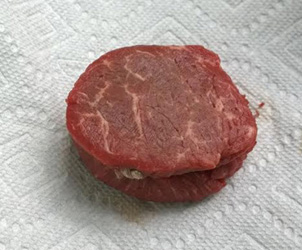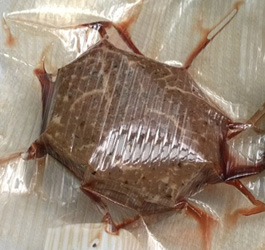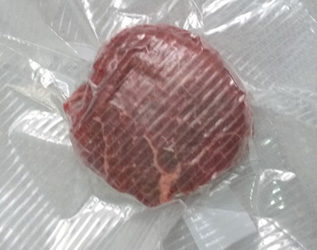Why Red Meat Turn Brown When Vacuum Sealed
There are many reasons that meat can turn brown. Cooking meat at a high temperature browns meat because of the maillard reaction. As meat ages it turns brown from oxidation. The oxidation process is a result of the bound iron molecule in myoglobin going from the ferrous to ferric form. This produces what is called metmyoglobin. Metmyoglobin is the cause of the characteristic brown coloration of meat that occurs as it ages.
But interestingly meat can quickly turn brown in minutes when it is vacuum packed. Vacuum packers have become very popular recently. Vacuum sealers help preserve foods by taking out the oxygen thereby prevent oxidation from occurring.
But in the case of red meat there is a profound effect on the color ---
 |
 |
|
Grass fed unprocessed beef shown as bright red due to oxygenated hemoglobin in meat |
A similar piece of unprocessed meat turns brown shortly after being vacuum sealed |
Why is meat red to begin with?
Meat is red when the pigment myoglobin that is contained in blood is bound to oxygen. Myoglobin is related to hemoglobin, which is the iron- and oxygen-binding protein in blood, specifically in the red blood cells. When oxygen is released from myoglobin there is a change in spectral properties of the myoglobin molecule. The result is a brownish color. The images above show two pieces of grass fed meat that were unprocessed. One was left exposed to the air and the other was vacuumed packed prior to cooking using the sous vide method. The strong vacuum pulled out air and drew oxygen molecules off the surface of the meat. Removing the meat from the bag showed that only the surface level turned brown.
Is Carbon Monoxide added to some meats to keep them red?
Carbon monoxide binds hemoglobin in much the same way that oxygen does, only 200x stronger. In fact CO will displace oxygen from hemoglobin (or myoglobin) because it has such great affinity for hemoglobin. It is a known fact that carbon monoxide is used in processed meats to keep the meat red for long periods of time. Shown below it is interesting that under vacuum the meat remained red.
 |
Why did this processed piece of red meat from the supermarket not turn brown when vacuum sealed? |
Carbon Monoxide in Meats
While carbon monoxide treated meat may not be harmful when fresh it can mislead the consumer who may not be able to smell the actual protein,. Adding carbon monoxide to meat will not only keep meat red while on the shelf but after it's spoiled.
23 January 2018 ---Abstract: Carbon Monoxide in Meat and Fish Packaging: Advantages and Limits
Due to increased demands for greater expectation in relation to quality, convenience, safety and extended shelf-life, combined with growing demand from retailers for cost-effective extensions of fresh muscle foods’ shelf-life, the food packaging industry quickly developed to meet these expectations. During the last few decades, modified atmosphere packaging (MAP) of foods has been a promising area of research, but much remains to be known regarding the use of unconventional gases such carbon monoxide (CO). The use of CO for meat and seafood packaging is not allowed in most countries due to the potential toxic effect, and its use is controversial in some countries. The commercial application of CO in food packaging was not then considered feasible because of possible environmental hazards for workers. CO has previously been reported to mask muscle foods’ spoilage, and this was the primary concern raised for the prohibition, as this may mislead consumers. This review was undertaken to present the most comprehensive and current overview of the widely-available, scattered information about the use of CO in the preservation of muscle foods. The advantages of CO and its industrial limits are presented and discussed. The most recent literature on the consumer safety issues related to the use of CO and consumer acceptance of CO especially in meat packaging systems were also discussed. Recommendations and future prospects were addressed for food industries, consumers and regulators on what would be a “best practice” in the use of CO in food packaging. All this promotes high ethical standards in commercial communications by means of effective regulation, for the benefit of consumers and businesses in the world, and this implies that industrialized countries and members of their regulatory agencies must develop a coherent and robust systems of regulation and control that can respond effectively to new challenges. Keywords: muscle foods, modified atmosphere packaging, CO, shelf-life, best practice, regulation. see full publication.
References and Selected Readings:
Science of Cooking
Why is Humidity Important in Cooking
What is the Maillard Reaction?
How is heat transferred during cooking?
What are the effects of the Maillard Reaction during cooking?
Health Risks in Cooking
What is the difference between LDL and HDL?
What are the different types of Omega-3 fatty acids?
What is the difference between nitrates and nitrites?
What is the difference between saturated and unsaturated fats?